重学Java 6 流程控制语句
我与我,至死不渝
? ? ? ? ? ——24.1.15
模块重点:
①会使用Scanner和Random
②会使用switch以及知道case的穿透性
③会使用if
④会使用for循环,while循环,嵌套循环
一、键盘录入_Scanner
1.概述:是Java定义好的一个类
2.作用:将数据通过键盘录入的形式放到代码中参与运行
3.位置:java.util
4.使用:
? ? ? ? ①导包:通过导包的方式找到要使用的类? ->? 导包位置:类上
? ? ? ? import java.util.Scanner;? ->? 导入包:明确使用的是哪个包下的哪个类的
? ? ? ?
????????②创建对象
? ? ? ? ? ? Scanner 变量名 = new Scanner(System.in);
? ? ? ?
????????③调用方法,实现键盘录入
? ? ? ? ? ? 变量名.nextInt()????????输入整数int型的
? ? ? ? ? ? 变量名.next()? ? ? ? 输入字符串String型的
1.Scanner键盘录入练习
package Better;
import java.util.Scanner;
public class Demo02Scanner_Practise {
public static void main(String[] args) {
//创建对象
Scanner sc = new Scanner(System.in);
//录入int型整数
int data1 = sc.nextInt();
System.out.println("data1 = " + data1);
//录入String字符串
String data2 = sc.next();
System.out.println("data2 = " + data2);
}
}
 ? ? ?
? ? ?
案例1
从键盘输入三位老人的年纪,并编写程序判断最大年龄是多大
package Better;
import java.util.Scanner;
public class Demo02Scanner_Practise {
public static void main(String[] args) {
Scanner sc = new Scanner(System.in);
int old1 = sc.nextInt();
int old2 = sc.nextInt();
int old3 = sc.nextInt();
int tmp = old1>old2?old1:old2;
int max = tmp>old3?tmp:old3;
System.out.println("max = " + max);
}
}

2.next和nextline的区别
变量名.next():录入字符串 -> 遇到空格和回车就结束录入了
变量名.nextLine():录入字符串 -> 遇到回车就结束录入了
import java.util.Scanner;
public class Demo03Scanner_differences {
public static void main(String[] args) {
Scanner sc = new Scanner(System.in);
String data1=sc.next();
System.out.println("data1 = " + data1);
String data2=sc.nextLine();
System.out.println("data2 = " + data2);
}
}
import java.util.Scanner;
public class Demo03Scanner_differences {
public static void main(String[] args) {
Scanner sc = new Scanner(System.in);
// String data1=sc.next();
// System.out.println("data1 = " + data1);
String data2=sc.nextLine();
System.out.println("data2 = " + data2);
}
}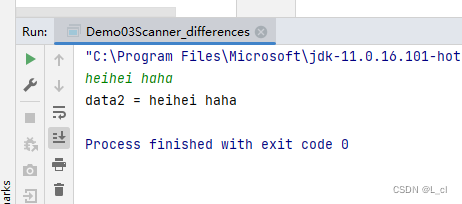
3.注意
当用Scanner输入语句时,记住Scanner输入的类型,在输入时只能输入对应类型,类型应相匹配
二、Random_随机数
1.概述:Java自带的一个类
2.作用:可以在指定范围内随机一个参数
3.位置:java.util
4.使用:
? ? ? ? ①导包:import java.util.Random
? ? ? ? ②创建对象:
? ? ? ? ? ?Random 变量名 = new Random()
? ? ? ? ③调用方法,生成随机数:
? ? ? ? ? ?变量名.nextInt() -> 在int的取值范围内随机一个整数
import java.util.Random;
public class Demo04Random {
public static void main(String[] args) {
//创建对象
Random rd = new Random();
int data = rd.nextInt();
System.out.println("data = " + data);
}
}
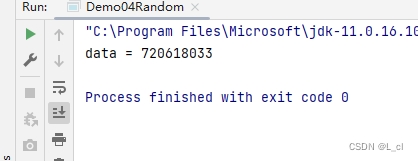
在指定范围内随机一个数:
nextInt(int bound) -> 在 0~(bound - 1)
? ? ? ? ①nextInt(10) -> 0 ~ 9
? ? ? ? ②在1~10之间随机一个数:nextInt(10) +?1 -> (0 ~?9) + 1 -> 1 ~ 10
? ? ? ? ③在1~100之间随机一个数:nextInt(100) + 1 -> (0 ~?99) + 1 -> 1 ~100
? ? ? ? ④在100~999之间随机一个数:nextInt(900) + 100 -> (0 ~ 899) + 100 -> 100 ~ 999
案例1:
在1~100之间随机一个数
import java.util.Random;
public class Demo04Random {
public static void main(String[] args) {
//创建对象
Random rd = new Random();
//1~100之间的随机数
int data = rd.nextInt(100+1);
System.out.println("data = " + data);
}
} ?
?
案例2:
在100~999之间随机一个数
public class Demo04Random {
public static void main(String[] args) {
//创建对象
Random rd = new Random();
//1~100之间的随机数
int data = rd.nextInt(100+1);
System.out.println("data = " + data);
//100~999之间随机一个数
int data1 = rd.nextInt(900)+100;
System.out.println("data1 = " + data1);
}
}

三、switch(选择语句)
1.switch基本使用
①格式:
? ? ? ? switch(变量){
? ? ? ? ? ? ? ? case 常量值1:
? ? ? ? ? ? ? ? ? ? ? ? 执行语句1;
? ? ? ? ? ? ? ? ? ? ? ? break;
? ? ? ? ? ? ? case 常量值2:
? ? ? ? ? ? ? ? ? ? ? ? 执行语句2;
? ? ? ? ? ? ? ? ? ? ? ? break;
? ? ? ? ? ? ? case 常量值3:
? ? ? ? ? ? ? ? ? ? ? ? 执行语句3;
? ? ? ? ? ? ? ? ? ? ? ? break;
? ? ? ? ……
? ? ? ? ? ? ? default:
? ? ? ? ? ? ? ? ? ? ? ? 执行语句n;
? ? ? ? ? ? ? ? ? ? ? ? break;
}
②执行流程:
? ? ? ? 用变量接收的值和下面常量值进行匹配,匹配上哪个case就执行哪个case对应的执行语句,如果以上所有case都没有匹配上,就走default对应的执行语句n
③break关键字:代表的是结束switch语句
④注意:switch能匹配什么类型的数据:
????????byte short int char 枚举类型 String类型 不能匹配浮点型数据
案例
public static void main(String[] args) {
Scanner sc = new Scanner(System.in);
System.out.println("请您输入一个1~4之间的整数");
int data = sc.nextInt();
switch (data){
case 1:
System.out.println("鹅鹅鹅");
break;
case 2:
System.out.println("\"曲项向天歌\" = " + "曲项向天歌");
break;
case 3:
System.out.println("\"白毛浮绿水\" = " + "白毛浮绿水");
break;
case 4:
System.out.println("\"红掌拨清波\" = " + "红掌拨清波");
break;
default:
System.out.println("请您输入1~4范围内的数字");
break;
}
}
}

2.case的穿透性
①如果没有break,就会出现case的穿透性,程序就会一直往下穿透执行,直到遇到了break或者switch代码执行完毕了,就停止了
②可以利用case的穿透性对代码进行优化,使代码简洁易懂
public static void main(String[] args) {
Scanner sc = new Scanner(System.in);
System.out.println("请您输入一个1~4之间的整数");
int data = sc.nextInt();
switch (data){
case 1:
System.out.println(" 鹅鹅鹅");
//break;
case 2:
System.out.println(" 曲项向天歌");
//break;
case 3:
System.out.println(" 白毛浮绿水");
//break;
case 4:
System.out.println(" 红掌拨清波");
//break;
default:
System.out.println("请您输入1~4范围内的数字");
break;
}
}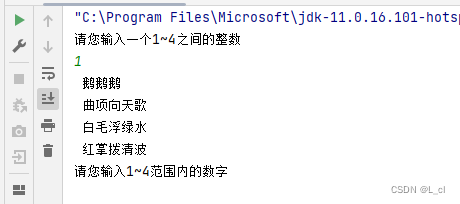
四、分支语句
1.if的第一种格式
①格式:
????????if(boolean表达式){
? ? ? ? ? ? ? ? 执行语句;
????????}
②执行流程:
? ? ? ? 先走if后面的boolean表达式,如果是true,就走if后面大括号中的执行语句,否则就不走
③注意:
? ? ? ? if后面跟的是boolean表达式,只要是结果为boolean型的,都可以放在小括号中,哪怕直接写一个true或false
案例
判断两个整数是否相等
public static void main(String[] args) {
Scanner sc = new Scanner(System.in);
System.out.println("请您输入两个数字:");
int num1 = sc.nextInt();
int num2 = sc.nextInt();
if(num1 == num2){
System.out.println("两个整数相等");
}
}
2.if的第二种格式
1.格式:
? ? ? ? if(boolean表达式){
? ? ? ? ? ? ? ? 执行语句1;
? ? ? ? }else{
? ? ? ? ? ? ? ? 执行语句2;
? ? ? ? }
2.执行流程:
? ? ? ? ①先走if后面的boolean表达式,如果是true,就走if后面的执行语句1
? ? ? ? ②否则就走else后面的执行语句2
public static void main(String[] args) {
Scanner sc = new Scanner(System.in);
System.out.println("请您输入两个数字:");
int num1 = sc.nextInt();
int num2 = sc.nextInt();
if(num1 == num2){
System.out.println("两个整数相等");
}
else{
System.out.println("两个整数不相等");
}
}案例1
任意给出一个整数,请用程序实现判断这个数是奇数还是偶数
public static void main(String[] args) {
Scanner sc = new Scanner(System.in);
int num = sc.nextInt();
if(num%2==1){
System.out.println(num + "是奇数");
}else{
System.out.println(num+"是偶数");
}
}
案例2
利用if else语句,求出两个数中的较大值
public static void main(String[] args) {
Scanner sc = new Scanner(System.in);
System.out.println("请您输入要比较的两个数");
System.out.println("请您输入第一个数");
int num1 = sc.nextInt();
System.out.println("请您输入第二个数");
int num2 = sc.nextInt();
if(num1>num2){
System.out.println("最大数是"+num1);
}else{
System.out.println("最大数是"+num2);
}
}
案例3
案例:从键盘输入年份,请输出该年的2月份的总天数,闰年29天,平年28天
闰年:①能被4整除,但不能被100整除 year%4==0 && year%100!=0
? ? ? ? ? ?②或者能直接被400整除 year%400==0
public static void main(String[] args) {
Scanner sc = new Scanner(System.in);
System.out.println("请输入一个年份");
int year = sc.nextInt();
if((year%4==0) && (year%100!=0)||year%400==0){
System.out.println("该年是闰年,二月有29天");
}else{
System.out.println("该年是平年,二月有28天");
}
}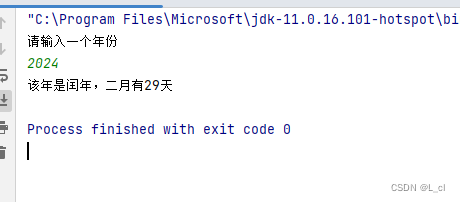
注意:若是boolean类型,则必定可以放入if表达式中
3.if的第三种格式
1.格式:
? ? ? ? if(boolean表达式){
? ? ? ? ? ? ? ? 执行语句1
? ? ? ? }else if(boolean表达式){
? ? ? ? ? ? ? ? 执行语句2
? ? ? ? }else if(boolean表达式){
? ? ? ? ? ? ? ? 执行语句3
? ? ? ? }……else{
? ? ? ? ? ? ? ? 执行语句n
? ? ? ? }
2.执行流程:
? ? ? ? 从if开始往下挨个判断,哪个if判断结果为true,就走哪个if对应的执行语句,如果以上所有的判断都是false,就走else对应的执行语句n
3.使用场景:2种情况以上的判断
案例1
输入要比较的两个数,判断两个数的大小关系
public static void main(String[] args) {
Scanner sc = new Scanner(System.in);
System.out.println("请您输入要比较的两个数");
System.out.println("请您输入第一个数");
int num1 = sc.nextInt();
System.out.println("请您输入第二个数");
int num2 = sc.nextInt();
if(num1 > num2){
System.out.println(num1+">"+num2);
} else if (num1 == num2) {
System.out.println(num1+"="+num2);
} else{
System.out.println(num1+"<"+num2);
}
}
注意:最后一种情况,不一定要用else,但是必须保证所有的情况都有
案例2
键盘输入一个星期数(1~7),输出对应的星期一、星期二、……星期日
public static void main(String[] args) {
Scanner sc = new Scanner(System.in);
System.out.println("请您输入星期数目1~7");
int week = sc.nextInt();
if(week == 1){
System.out.println("星期一");
} else if (week == 2) {
System.out.println("星期二");
} else if (week == 3) {
System.out.println("星期三");
} else if (week == 4) {
System.out.println("星期四");
} else if (week == 5) {
System.out.println("星期五");
} else if (week == 6) {
System.out.println("星期六");
} else if (week == 7) {
System.out.println("星期日");
} else {
System.out.println("您输入错误");
}
}
案例3
根据最新的年龄阶段划分标准:
? ? ? ? 0~6岁为婴幼儿
? ? ? ? 7~12岁为少儿
? ? ? ? 13~17岁为青少年
? ? ? ? 18~45岁为青年
? ? ? ? 46~69岁为中年
? ? ? ? 69岁以上为老年
请键盘录入一个年龄,判断属于什么年龄段
public static void main(String[] args) {
System.out.println("请您输入一个年龄");
Scanner sc = new Scanner(System.in);
int age = sc.nextInt();
if(age>=0 && age<=6){
System.out.println(age+"岁属于婴幼儿");
}else if(age>=7 && age<=12){
System.out.println(age+"岁属于少儿");
}else if(age>=13 && age<=17){
System.out.println(age+"岁属于青少年");
}else if(age>=18 && age<=45){
System.out.println(age+"岁属于青年");
}else if(age>=46 && age<=69) {
System.out.println(age+"岁属于中年");
}else if (age>=70) {
System.out.println(age+"岁属于老年");
}else{
System.out.println("输入错误");
}
}
4.switch和if的区别:
1.switch:会直接跳到相匹配的case
2.if:从上到下挨个判断 -> 实际开发主要使用if判断 灵活
五、循环语句
当我们发现一件事情或者一段代码在反复执行,我们就可以考虑使用循环语句了
1.for循环的使用
1.格式:
? ? ? ? for(初始化变量;比较;步进表达式)
? ? ? ? ? ? ? ? 循环语句 -> 哪段代码循环执行,就将哪段代码放在此处
? ? ? ? }
2.执行流程:
? ? ? ? ①先走初始化变量
? ? ? ? ②比较,如果是true,走循环语句,走步进表达式(初始化的变量的值进行变化)
? ? ? ? ③再比较,如果还是true,继续走循环语句,走步进表达式
? ? ? ? ④再比较,直到比较为false,循环就结束了

public static void main(String[] args) {
for (int i = 0; i < 3; i++) {
System.out.println("一切都会好的,我一直相信");
}
}
快捷键:次数.fori
5.fori
public static void main(String[] args) {
for (int i = 0; i < 3; i++) {
System.out.println("一切都会好的,我一直相信");
}
for (int j = 0; j < 5; j++) {
System.out.println("万事胜意");
}
}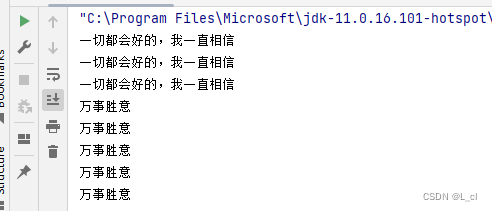
案例1
for循环:求1-3之间的数据和,并把求和结果输出到控制台上
1+2+3
步骤:
? ? ? ? ①定义一个变量,来接收两个数的和,sum
? ? ? ? ②利用for循环将1~3表示出来
? ? ? ? ③再循环的过程中,两两相加,将结果赋值给sum
? ? ? ? ④输出sum
public static void main(String[] args) {
// ①定义一个变量,来接收两个数的和,sum
int sum = 0;
// ②利用for循环将1~3表示出来
for (int i = 1; i <= 3; i++) {
// ③再循环的过程中,两两相加,将结果赋值给sum
sum+=i;
i=i++;
}
// ④输出sum
System.out.println(sum);
}
案例2
for循环:求出1~100之间的偶数和
步骤:
? ? ? ? ①定义一个变量sum,接收两个偶数的和
? ? ? ? ②利用for循环将1~100表示出来
? ? ? ? ③判断,如果是偶数则把值加给sum
? ? ? ? ④输出sum
public static void main(String[] args) {
// ①定义一个变量sum,接收两个偶数的和
int sum =0;
// ②利用for循环将1~100表示出来
for (int i = 1; i <= 100; i++) {
// ③判断,如果是偶数则把值加给sum
if(i%2==0){
sum+=i;
}
}
// ④输出sum
System.out.println(sum);
}
改进代码:
public static void main(String[] args) {
int sum = 0;
for (int i = 0; i <= 100; i = i + 2) {
sum += i;
}
System.out.println("一百以内偶数和为" + sum);
}案例3
统计一下1~100之间的偶数个数
步骤:
? ? ? ? ①定义一个变量count,用来计数
? ? ? ? ②利用for循环将1~100表示出来
? ? ? ? ③判断,如果是偶数,count++
? ? ? ? ④输出count
public static void main(String[] args) {
// ①定义一个变量count,用来计数
int count = 0;
// ②利用for循环将1~100表示出来
for (int i = 1; i <= 100; i++) {
// ③判断,如果是偶数,count++
if(i%2==0){
count++;
}
}
// ④输出count
System.out.println("1~100间偶数个数为:"+count);
}
2.while循环
1.格式:
? ? ? ? 初始化变量:
? ? ? ? while(比较){
? ? ? ? ? ? ? ? 循环语句;
? ? ? ? ? ? ? ? 步进表达式
? ? ? ? }
2.执行流程:
? ? ? ? ①初始化变量
? ? ? ? ②比较,如果是true,就走循环语句,走步进表达式
? ? ? ? ③再比较,如果还是true,继续走循环语句,继续走步进表达式
? ? ? ? ④再比较,直到比较为false,循环结束
public static void main(String[] args) {
int i = 0;
while(i<5){
System.out.println("万事胜意");
i++;
}
}
案例1
while循环:求1-3之间的数据和,并把求和结果输出到控制台上
1+2+3
步骤:
? ? ? ? ①定义一个变量,来接收两个数的和,sum
? ? ? ? ②利用while循环将1~3表示出来
? ? ? ? ③再循环的过程中,两两相加,将结果赋值给sum
? ? ? ? ④输出sum
public static void main(String[] args) {
// 定义一个变量,来接收两个数的和,sum
int sum = 0;
// ②利用while循环将1~3表示出来
int i = 1;
while(i<4){
// ③再循环的过程中,两两相加,将结果赋值给sum
sum+=i;
i++;
}
// ④输出sum
System.out.println(sum);
}
案例2
while循环:求出1~100之间的偶数和
步骤:
? ? ? ? ①定义一个变量sum,接收两个偶数的和
? ? ? ? ②利用while循环将1~100表示出来
? ? ? ? ③判断,如果是偶数则把值加给sum
? ? ? ? ④输出sum
public static void main(String[] args) {
// ①定义一个变量sum,接收两个偶数的和
int sum = 0;
// ②利用while循环将1~100表示出来\
int i = 1;
while(i<=100) {
// ③判断,如果是偶数则把值加给sum
if(i%2==0){
sum+=i;
}
i++;
}
// ④输出sum
System.out.println(sum);
} ?
?
案例3
统计一下1~100之间的偶数个数
步骤:
? ? ? ? ①定义一个变量count,用来计数
? ? ? ? ②利用while循环将1~100表示出来
? ? ? ? ③判断,如果是偶数,count++
? ? ? ? ④输出count
public static void main(String[] args) {
// ①定义一个变量count,用来计数
int count = 0;
// ②利用while循环将1~100表示出来
int i = 1;
while(i<=100) {
// ③判断,如果是偶数,count++
if(i%2==0){
count++;
}
i++;
}
// ④输出count
System.out.println(count);
}
案例4*
世界最高山峰是珠穆朗玛峰(8844.43米 = 8844430毫米),假如有一张足够大的纸,它的厚度是0.1毫米,请问,我折叠多少次,可以折成珠穆朗玛峰的高度?
步骤:
? ? ? ? ①定义一个变量表示山峰的高度:mountain
? ? ? ? ②定义一个变量表示纸的厚度:h
? ? ? ? ③定义一个变量表示折纸的次数:i
? ? ? ? ④利用while循环进行比较,如果h?< mountain,就循环对折
public static void main(String[] args) {
//① 定义一个变量表示山峰的高度:mountain
int mountain = 8844430;
//② 定义一个变量表示纸的厚度:h
double h = 0.1;
//③ 定义一个变量表示折纸的次数:i
int i = 0;
//④ 利用while循环进行比较,如果h?< mountain,就循环对折
while(h<mountain){
h *= 2;
i++;
}
System.out.println("折叠了"+i+"次");
}
3.do…while循环
1.格式:
? ? ? ? 初始化变量:
????????do{
? ? ? ? ? ? ? ? 循环语句;
? ? ? ? ? ? ? ? 步进表达式
? ? ? ? }while(比较);
2.执行流程:
? ? ? ? ① 初始化变量
? ? ? ? ② 走循环语句
????????③ 走步进表达式
????????④ 判断,如果是true,继续循环,直到比较为false,循环结束
3.特点:
? ? ? ? 至少循环一次
public static void main(String[] args) {
int i = 0;
do{
System.out.println("一切都会好的");
i++;
}while (i < 5);
}
4.循环控制语句 break&continue?
1.break:
? ? ? ? ①在switch中代表结束switch语句
? ? ? ? ②在循环中代表循环结束
2.continue:
? ? ? ? 结束当前本次循环,直接进入下一次循环,直到条件为false为止
break:
public static void main(String[] args) {
for (int i = 1; i <=5 ; i++) {
if(i==3){
// 结束循环
break;
// 结束本次循环,进入下一次循环
//continue
}
System.out.println("万事胜意");
}
}
continue:
public static void main(String[] args) {
for (int i = 1; i <=5 ; i++) {
if(i==3){
// 结束循环
//break;
// 结束本次循环,进入下一次循环
continue;
}
System.out.println("万事胜意");
}
}
5.死循环
1.概述:
? ? ? ? 一直循环
2.什么条件下一直循环:
? ? ? ? 比较条件一直是true
for循环:
public static void main(String[] args) {
int count = 0;
for (int i = 0; i < 3; ) {
count++;
System.out.println("一切都会好的"+count);
}
}
while循环:
public static void main(String[] args) {
int count = 0;
// for (int i = 0; i < 3; ) {
// count++;
// System.out.println("一切都会好的"+count);
// }
while(true){
System.out.println(count);
count++;
}
}
6.嵌套循环
1.概述:循环中还有循环
? ? ? ? eg、时分秒
2.执行流程:
? ? ? ? 先执行外层循环,在进入内层循环,内层循环就一直循环,直到内层循环结束,外层循环进入下一次循环,直到外层循环结束了,整体结束
public static void main(String[] args) {
for (int shi = 0; shi < 24; shi++) {
for (int fen = 0; fen < 60; fen++) {
for (int miao = 0; miao < 60; miao++) {
System.out.println(shi+"时"+fen+"分"+miao+"秒");
}
}
}
}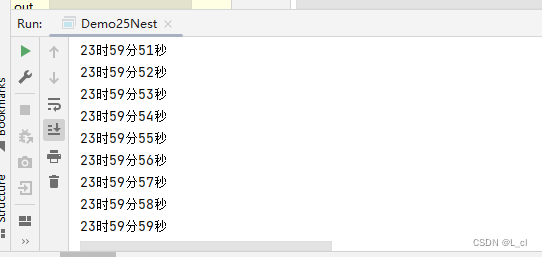
练习1:打印矩形
public static void main(String[] args) {
//外层循环控制行
for (int i = 0; i < 5; i++) {
//内层循环控制列
for (int j = 0; j < 5; j++) {
System.out.print("* ");
}
System.out.println();
}
}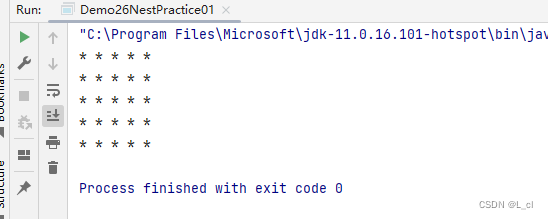
练习2:打印直角三角形
public static void main(String[] args) {
for (int i = 1; i < 5; i++) {
for (int j = 0; j < i; j++) {
System.out.print("* ");
}
System.out.println();
}
}
练习3* 猜数字小游戏
1.创建Scanner和Random对象
2.调用Random中的nextInt(100)+1在1~100之间随机一个数? ? ? ? rdNumber
3.调用Scanner中的nextInt()方法,键盘录入一个要猜的数? ? ? ? scNumber
4.如果scNumber > rdNumber,证明猜大了
5.如果scNumber <?rdNumber,证明猜小了
6.如果scNumber =?rdNumber,证明猜对了
public class Demo28GuessNumberGame {
public static void main(String[] args) {
//只允许七次之内猜出
int i = 0;
//1.创建Scanner和Random对象
Scanner sc = new Scanner(System.in);
Random rd = new Random();
//2.调用Random中的nextInt(100)+1在1~100之间随机一个数 rdNumber
int rdNumber = rd.nextInt(99) + 1;
while (i < 7) {
i++;
//3.调用Scanner中的nextInt()方法,键盘录入一个要猜的数 scNumber
System.out.println("请您输入您要猜的数字:");
int scNumber = sc.nextInt();
//4.如果scNumber > rdNumber,证明猜大了
if (scNumber > rdNumber) {
System.out.println("猜大了");
System.out.println("这是第" + i + "次猜");
continue;
}
//5.如果scNumber < rdNumber,证明猜小了
else if (scNumber < rdNumber) {
System.out.println("猜小了");
System.out.println("这是第" + i + "次猜");
continue;
}
//6.如果scNumber = rdNumber,证明猜对了
else {
System.out.println("猜对了");
System.out.println("这是第" + i + "次猜");
break;
}
}
}
}
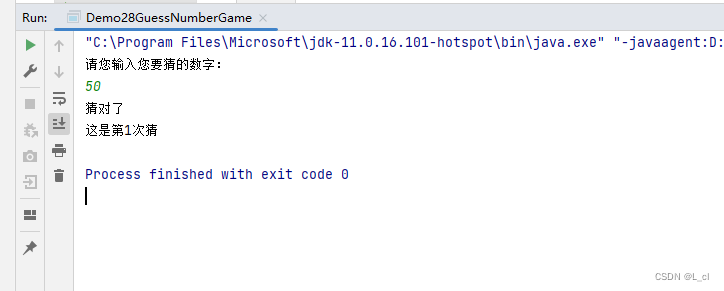
六、总结
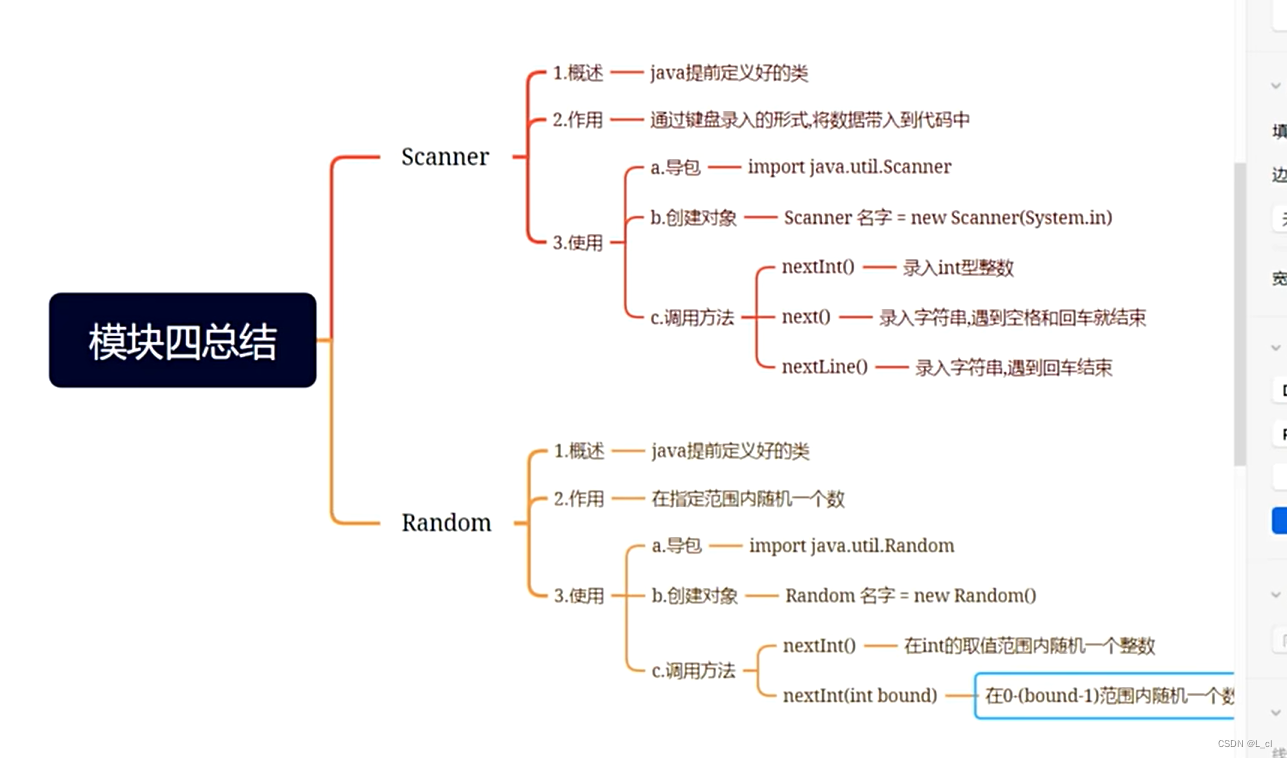






本文来自互联网用户投稿,该文观点仅代表作者本人,不代表本站立场。本站仅提供信息存储空间服务,不拥有所有权,不承担相关法律责任。 如若内容造成侵权/违法违规/事实不符,请联系我的编程经验分享网邮箱:chenni525@qq.com进行投诉反馈,一经查实,立即删除!
- Python教程
- 深入理解 MySQL 中的 HAVING 关键字和聚合函数
- Qt之QChar编码(1)
- MyBatis入门基础篇
- 用Python脚本实现FFmpeg批量转换
- SQL手工注入漏洞测试(MySQL数据库)
- EMC整改评估要素,需要提供什么?
- Course3-Week3-强化学习
- 基于ssm流浪动物救助及领养管理系统
- mini-spring-Bean含参实例化(三)
- 今天开始准备蓝桥杯:快速排序
- thinkphp6.0升级到8.0
- C++ Qt开发:QItemDelegate自定义代理组件
- 怎样解决注塑行业的难点与现状?
- 『JavaScript』深入理解JavaScript字符串的基础操作与内置方法